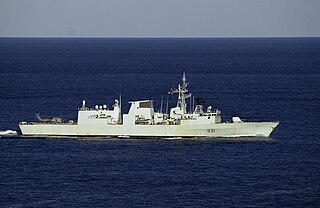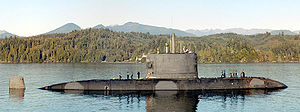
The Upholder/Victoria-class submarines, also known as the Type 2400, are the class of the diesel-electric submarines built in the United Kingdom in the 1980s to supplement the nuclear submarines in the Submarine Service of the British Royal Navy.

HMCS Toronto is a Halifax-class frigate that has served in the Canadian Forces since 1993. Toronto is the fourth ship in her class which is the name for the Canadian Patrol Frigate Project. She is the second RCN ship to be named for Canada's largest city. When not on operations she is assigned to Maritime Forces Atlantic (MARLANT) and is based at CFB Halifax. Toronto serves on MARLANT missions protecting Canada's sovereignty in the Atlantic Ocean and enforcing Canadian laws in its territorial sea and exclusive economic zone.

The Halifax-class frigate, also referred to as the City class, is a class of multi-role patrol frigates that have served the Royal Canadian Navy since 1992. The class is the outcome of the Canadian Patrol Frigate Project, which dates to the mid-1970s. HMCS Halifax was the first of an eventual twelve Canadian-designed and Canadian-built vessels which combine traditional anti-submarine capabilities with systems to deal with surface and air threats as well. All ships of the class are named after a major city in each province plus the cities of Ottawa and Montreal.

HMCS Chicoutimi is a Victoria-class long-range hunter-killer (SSK) submarine of the Royal Canadian Navy, originally built and operated by the Royal Navy as HMS Upholder. Shortly after being handed over by the United Kingdom to Canada she was involved in a partial flooding incident which resulted in a fire at sea. The incident sparked a fierce debate over the value of the purchase of this group of second-hand vessels, as well as the handover inspection process. The subsequent investigation "determined the fire was caused by human, technical and operational factors, [and] the board cleared the commanding officer and crew of any blame." The submarine was repaired and entered Canadian service in 2015.

HMCS Halifax is a Halifax-class frigate that has served in the Royal Canadian Navy and Canadian Forces since 1992. Halifax is the lead ship in her class which is the name for the Canadian Patrol Frigate Project. She is the second vessel to carry the designation HMCS Halifax. She carries the hull classification symbol FFH 330.

HMCS Vancouver is a Halifax-class frigate, of the Royal Canadian Navy launched on 8 July 1989, as the second vessel of her class. She is based at CFB Esquimalt on the west coast of Canada, and is the third vessel to be named after Vancouver, British Columbia.

HMCS Calgary is a Halifax-class frigate that has served in the Canadian Forces and Royal Canadian Navy since 1995. Calgary is the sixth vessel in her class and the second vessel to carry the designation HMCS Calgary. She was built as part of the Canadian Patrol Frigate Project. Calgary began the FELEX refit in June 2012. She is assigned to Maritime Forces Pacific (MARPAC) and is homeported at CFB Esquimalt. Calgary serves on MARPAC missions protecting Canada's sovereignty in the Pacific Ocean and enforcing Canadian laws in its territorial sea and exclusive economic zone.

HMCS Ottawa is a Royal Canadian Navy Halifax-class frigate. Ottawa is the twelfth and final ship of the Halifax class that were built as part of the Canadian Patrol Frigate Project. She is the fourth vessel to carry the name HMCS Ottawa. The first three were named for the Ottawa River. This ship is the first named for Canada's national capital, the City of Ottawa. She is assigned to Maritime Forces Pacific (MARPAC) and is homeported at HMC Dockyard, CFB Esquimalt. Ottawa serves on MARPAC missions protecting Canada's sovereignty in the Pacific Ocean and enforcing Canadian laws in its territorial sea and Exclusive Economic Zone. Ottawa has also been deployed on missions throughout the Pacific and to the Indian Ocean; specifically the Persian Gulf and Arabian Sea on anti-terrorism operations.

HMCS Regina is a Halifax-class frigate that has served in the Canadian Forces and Royal Canadian Navy since 1993. Regina is the fifth vessel in her class which is the name for the Canadian Patrol Frigate Project. She is the second vessel to carry the designation HMCS Regina. She is assigned to Maritime Forces Pacific (MARPAC) and is homeported at CFB Esquimalt.

HMCS St. John's is a Halifax-class frigate that has served in the Canadian Forces and the Royal Canadian Navy since her commissioning in 1996. She is the eleventh of twelve ships in her class which is based on the Canadian Patrol Frigate Project. St. John's is named after the city of St. John's, Newfoundland and Labrador, a port city associated with Canadian naval history and heritage, and is the first ship in the Royal Canadian Navy to bear the name.

HMCS Ville de Québec is a Halifax-class frigate that has served in the Canadian Forces and Royal Canadian Navy since 1993. Ville de Québec is the third vessel in her class which is the name for the Canadian Patrol Frigate Project. The frigate is the second Royal Canadian Navy ship to be named Ville de Québec and is Canada's only fully bilingual warship. She is assigned to Maritime Forces Atlantic (MARLANT) and is homeported at CFB Halifax. The vessel serves on MARLANT missions protecting Canada's sovereignty in the Atlantic Ocean and enforcing Canadian laws in its territorial sea and exclusive economic zone.

HMCS Winnipeg is a Halifax-class frigate that has served in the Royal Canadian Navy since 1996. Winnipeg is the ninth ship in her class, whose design emerged from the Canadian Patrol Frigate Project. She is the second Canadian warship to carry the name HMCS Winnipeg. Winnipeg serves on Canadian Forces MARPAC missions protecting Canada's sovereignty in the Pacific Ocean and the Arctic Ocean and in enforcing Canadian laws on its territorial oceans and Exclusive Economic Zone. The vessel has been deployed on missions throughout the Pacific, and also to the Indian Ocean; specifically on anti-terrorism operations in the Persian Gulf and the Arabian Sea, and counter-piracy operations off the coast of Somalia. The ship is assigned to the Maritime Forces Pacific (MARPAC), and she has her home port at the Canadian Forces Maritime Base at Esquimalt.

HMCS Algonquin was an Iroquois-class destroyer that served in the Royal Canadian Navy (RCN) from 1973 to 2015.

HMCS Yellowknife is a Kingston-class coastal defence vessel that has served in the Canadian Forces since 1998. Yellowknife is the seventh ship of her class. She is the first vessel to use the designation Yellowknife in the Royal Canadian Navy. The coastal defence vessel is assigned to Maritime Forces Pacific (MARPAC) and is homeported at CFB Esquimalt.

HMCS Corner Brook is a long-range hunter-killer submarine (SSK) of the Royal Canadian Navy. She is the former Royal Navy Upholder-class submarine HMS Ursula (S42), purchased from the British at the end of the Cold War. She is the third boat of the Victoria class and is named after the city of Corner Brook, Newfoundland. The submarine was launched in 1989 and entered service with the Royal Navy in 1992. The Royal Navy laid Ursula up in 1994. In 1998, Canada acquired the submarine from the United Kingdom. The vessel entered service with the Canadian Armed Forces in 2003. Renamed Corner Brook, the submarine took part in several military exercises both internationally, such as NATO exercises and domestic, such as Operation Nanook. In June 2011, the submarine ran aground in Nootka Sound, damaging the vessel's bow. The submarine was sent for refit in 2014 to complete the repairs.

HMCS Qu'Appelle was a Mackenzie-class destroyer that served in the Royal Canadian Navy and later the Canadian Forces. The ship's insignia and logo was the head of a fox facing forward centered in a diagonal line double white with a red center sqiggley line from the top left to bottom right. The moniker of the ship was "Follow the Fox".

HMCS Saskatchewan was a Mackenzie-class destroyer that served in the Royal Canadian Navy (RCN) and later the Canadian Forces. She was the second Canadian naval unit to bear the name HMCS Saskatchewan. The ship was named for the Saskatchewan River which runs from Saskatchewan to Manitoba in Canada.

HMCS Beacon Hill was a River-class frigate that served in the Royal Canadian Navy (RCN) as an ocean convoy escort during the Second World War. She fought primarily in the Battle of the Atlantic. In 1954 she was converted to a Prestonian-class frigate and served until 1957. She was named for Victoria, British Columbia, but because HMS Victorious was in service with the Royal Navy, the RCN, in an effort to avoid confusion, chose to honour the city by choosing another name associated with it.

HMCS Windsor is a long-range hunter-killer (SSK) submarine of the Royal Canadian Navy, the second submarine of the Victoria class. She is named after the city of Windsor, Ontario. Built for the Royal Navy as the Upholder-class submarine HMS Unicorn she was purchased by Canada when the United Kingdom decided to move to an all-nuclear power fleet.

HMCS Waskesiu was a River-class frigate of the Royal Canadian Navy. The frigate served as a convoy escort in the Battle of the Atlantic during the Second World War. It was the first frigate constructed and commissioned into the Royal Canadian Navy. Following the war, the vessel was sold to India where it was renamed Hooghly. Named after the town of Prince Albert, Saskatchewan, there was already a warship named "Prince Albert". The Royal Canadian Navy then named the ship after the town closest to Prince Albert National Park.


















